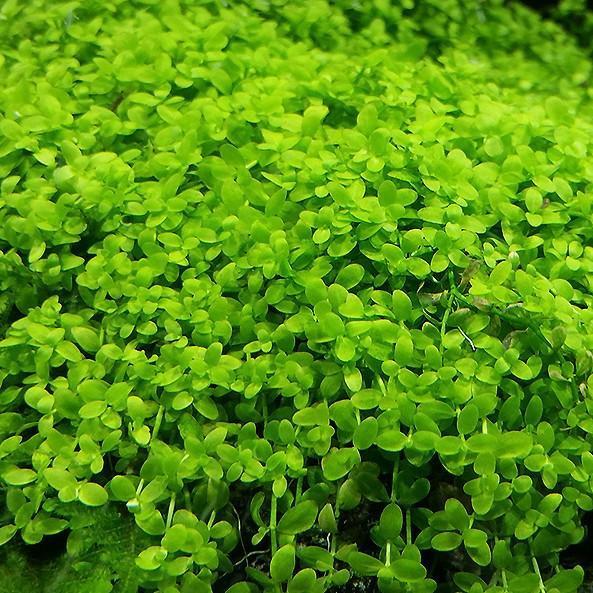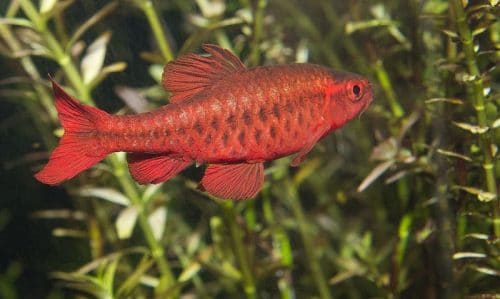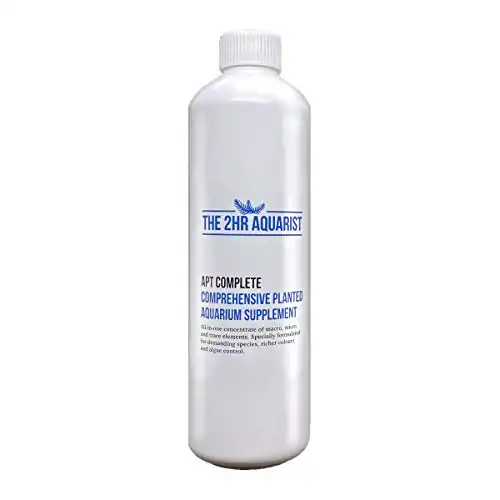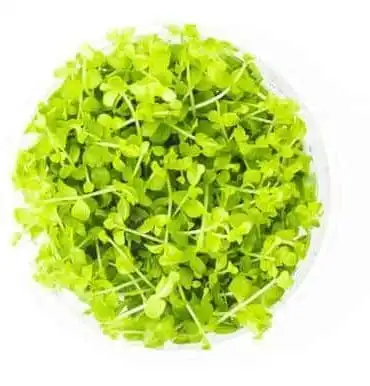Thank you for visiting! By the way… any links on this page that lead to products on Amazon and other stores/partners are affiliate links Aquarium Store Depot earns a commission if you make a purchase.
The micranthemum Monte Carlo plant is one of the most popular carpeting plants for moderately lit freshwater tropical aquascapes. These aquatic plants are great for beginners and they grow fast, creating a dense and beautiful bright green carpet. That isn’t all they can be used for, however, these tiny plants can be grown as epiphytes too. Grown this way, they make for an eye-catching cascading carpet over hardscape features like driftwood and rock.
This blog post will teach you how to care for your Monte Carlo Plant while also providing information about where it comes from, what it looks like, and more. Let’s get started!
A Brief Overview Of The Monte Carlo Plant
| Scientific Name | Micranthemum tweediei |
| Common Names | Monte Carlo |
| Family | Scrophulariaceae |
| Origin | South America (Argentina) |
| Skill Level | Easy to Moderate |
| Lighting | Moderate 30-50 PAR (umols) |
| Tank Placement | Foreground, midground |
| Flow Rate | Low, Moderate |
| Temperature Range | 68-77° F |
| Height | 1-2 Inches |
| pH Range | 6-7.5 |
| Propagation | Division |
| Growth Rate | Moderate, Fast |
| Feed Type | Column and Root Feeder |
| CO2 Requirement | Yes |
Origins And Habitat
Micranthemum tweediei ‘Monte Carlo’ is a green freshwater plant from Argentina in South America. In nature, these aquatic plants are found in shallow freshwater systems like streams, lakes, and bogs that get plenty of sunlight.
They are amphibious plants that can be found growing underwater, on saturated ground, or growing emersed.
What Does This Plant Look Like?

Monte Carlo1 is a beautiful, light green-colored carpeting aquarium plant that grows as a dense, low, and spreading mound. Under good light, these aquarium plants spread laterally at a good rate, and don’t grow much taller than about 2 inches.
Micranthemum Monte Carlo leaves are small and rounded and these plants have tiny roots. In appearance, this aquatic plant has a lot in common with another well-known carpeting plant, Dwarf Baby Tears.
This aquatic plant works really well in Iwagumi and Dutch-style aquascapes but will suit any layout that demands for carpeting plants. With care and maintenance you can create foreground planted carpets that will be eye popping.
Placement And Lighting
Monte Carlo is most often grown as a carpet plant in the foreground and midground. The aquarium plant is pretty versatile, however, and works just as well if grown as an epiphyte.
To grow this plant as an epiphyte, you can attach it to hardscape elements like driftwood, cave ornaments, or lava rock. If your hardscape element does not have suitable holes or cracks to hold the roots of this plant, you may need to attach it using nylon thread or superglue.
These aquarium plants need medium to high lighting to maintain a dense, low, and compact growth form. Plants grown under inadequate lighting will tend to grow tall and thin.
Plants grown on hardscape features tend to be closer to the light source and therefore might do well under weaker light, but it’s always important to factor in the depth of the water.
What Are Good Tank Mates?
Micranthemum Monte Carlo is great for community or species-only fish tanks. Especially where schooling fish are kept. Most species of tropical freshwater fish can be kept with this aquarium plant, as long as they share the same water parameter needs. Some great smaller fish would include:

- Cherry barbs
- Small Tetras like Neon tetras
- Minnows
- Danios
Fish Species To Avoid
One of the greatest challenges to growing a beautiful carpet of Monte Carlo is getting the plants to stay put when you first plant them. Fish like corydoras catfish and Kuhli loaches that forage by sifting through the substrate can easily dislodge these plants before the carpet becomes well established.
Avoid growing this aquatic plant in goldfish tanks since this is a plant they will feed on. Other fish to avoid keeping with Monte Carlo are:
- African cichlids
- Silver Dollars
- Buenos Aires Tetras
Feeding A Plant (Fertilization)
As an aquarium plant that gathers nutrients from both the substrate and the water column, Micranthemum Monte Carlo will benefit from a fertile growing medium as well as a liquid fertilizer. If grown in an inert substrate like gravel or sand, this excellent foreground plant will definitely benefit from the addition of root tabs.
Plants grown on rocks and other hardscape features will need to get all the nutrients they need from the water column, making liquid fertilizer essential for good growth. For any carpeting and other heavy feeding plants, I recommend APT complete. It is the best all around liquid fertilizer on the market.
Editor's Choice
Made by an aquascaper for aquascapers. This is the best all around aquarium plant fertilizer on the market. Marco and micronutrients in one bottle!
Use Coupon Code ASDComplete for 10% off your order!
How Much And How Often To Feed
How frequently you choose to feed this aquarium plant is going to depend on a couple of factors. Under high lighting and CO2, Micranthemum ‘Monte Carlo’ will require a steady supply of nutrients to keep up with the fast growth that these conditions stimulate.
This could mean daily to weekly doses of a supplement like Seachem flourish in the water column are needed. In tanks with only moderate lighting and a healthy stock of fish, you can get away with feeding once every week or two.
CO2 Injection
Monte Carlo, like all plants, needs light and carbon dioxide to grow. The background level of CO2 in aquariums is typically too low for this aquarium plant to develop into a tight, compact carpet. For this reason, CO2 injection is recommended for optimal growth.
How Much CO2 Do You Need?
The aquarist should aim to maintain dissolved CO2 levels of about 30ppm (parts per million) in their aquarium. This is the ‘sweet spot’ that results in optimal aquarium plant growth while remaining safe for fish and other livestock.
Getting your CO2 levels to 30ppm can take a little fine-tuning, but with a bubble counter and drop checker, you should be able to get it dialed in. It takes a little while for dissolved CO2 levels to rise in the aquarium so start off slow. Keep an eye on the color of your drop checker and once it stays stable at the right levels, observe your bubble count.
Whether you’re using a standard or an in-line diffuser, make sure you set your drop checker well away from the CO2 entering the tank for more accurate results. If you are looking for a combo package for a CO2 regulator. Check out this link.
Premium Pick
Everything you need to get started. A professional level CO2 system.
How long Should You Run CO2?
Plants can only grow effectively when they have access to enough CO2 and light. They use these energy sources at the same time so you only really need to run your pressurized CO2 system when the lights are on.
It takes a little while for the CO2 in your aquarium to build up to that sweet spot of 30ppm, however, so ideally, you should be running your CO2 system on a separate timer that starts up about 2 hours before the lights go on. You can have your CO2 injection system shut down at the same time as the lights, or a little earlier because some CO2 will remain available in the system for a while.
Plant Care
Under good light and proper conditions, Micranthemum Monte Carlo grows pretty fast and can be pretty invasive, which is great if you enjoy working on your aquascape, or maybe not that great if you’re looking for a low-maintenance option.
This species also has a habit of crowding out other aquatic plants so if you’re looking for a mixed species carpet, this may take a bit of extra trimming on your part.
Apart from trimming with a sharp pair of curved trimming scissors, it’s also possible to thin out your Monte Carlo carpet using a fine pair of aquascaping tweezers or pincettes. This is a delicate procedure though, the aquarist needs to take care not to uproot more of the aquarium plant than is necessary. Regular trimming is a must to keep the dense shape of this plant.
This aquascape set will get you started with pruning and trimming your prized plants to maintain that show winning look!
Planted Tank Conditions
The Monte Carlo plant does best in freshwater tropical aquariums that are on the cooler side, say between 68-77° F. These plants have a pretty wide tolerance for water hardness.
They need a decent amount of light, especially if you want a dense, low growing carpet in the foreground and midground of your aquascape. Although these plants can be grown without added CO2, they will perform better if this is provided.
Maintaining parameters

Being a dense carpeting aquarium plant, Micranthemum Monte Carlo will tend to capture fish waste and detritus and keep it trapped within its foliage (Picture Source). Although this can provide nutrients to the plant, it could potentially result in ammonia spikes in time if left unmanaged.
For this reason, a dense carpet of Monte Carlo is not advised in tanks with high stocking rates and a lot of waste. A good clean-up crew of small inverts like freshwater shrimp is also helpful in this regard.
It is possible to vacuum over a Monte Carlo plant carpet to capture waste that has collected beneath it but special care should be taken to not uproot the plants in the process as they tend to have pretty week root systems. Some aquarists have had success by fitting a grid-like material over the end of their vacuum to help to prevent sucking up the plants.
Water Quality
Maintaining great water quality and tank conditions is important for all aquarium plants and animals, and Monte Carlo is no exception. In tanks with fish, a partial water change every week or two is recommended and this is a great time to test water parameters with aquarium test kits and give your plants a trim too.
Be sure to use a water conditioner during water changes to neutralize harmful chemicals that may be present in your local tap water.
Filtration
It is best to use a filter with a pre-filter sponge over its inlet when growing fine aquarium plants like Monte Carlo. This is because trimmings or small plants that have come loose from the substrate can get sucked into your filter and cause blockages. Due to the nature of this plant, a high quality hang on the back filter or canister filter is recommended to keep the aquarium clear of plant and matter debris.
Flow
Micranthemum Monte Carlo has pretty small, fine roots that are easily loosened from the substrate. For this reason, direct, strong flow is a bad idea as it can dislodge your carpet.
Some flow is important, however, as this ensures a good distribution of CO2 and nutrients throughout your tank and keeps waste particles from settling on your plants before they can be processed in the filter. Grow this aquarium plant in a tank with a low to moderate flow for best results.
Aquarium Maintenance
Testing Water Conditions
Regular testing of water conditions should be part of your aquarium maintenance routine. You can use either strip tests or liquid tests, but be sure to keep an eye on parameters like ammonia and nitrites, particularly if you have livestock in your aquascape.
Other important parameters to keep an eye on in the aquarium are pH, general hardness, and carbonate hardness. You should, of course, also have a thermometer and keep an eye on your water temperature regularly to alert you to a malfunctioning heater.
How To Set Up Your Aquarium
Monte Carlo can be grown in a few different ways. These plants can be started off using the dry-start method or simply planted into the substrate of an established aquascape using a pair of fine aquarium tweezers. The video below from WASABI describes how to plant and prep this plant.
Use a good quality aqua-soil as your substrate, or if using an inert substrate, be sure to use root tabs from time to time to provide nutrients to the root zone. A third substrate option is to use a layer of an inert material like sand or gravel over a layer of nutrient-containing dirt.
Monte Carlo plant roots will develop better in gravel than sand, although the plants can be pretty easily dislodged from the substrate in a really coarse medium, so go for a substrate with a moderate texture.
As a small, carpeting plant, this species can be grown in just about any size aquarium, from just a few gallons and up.
Although it is possible to grow this aquatic plant without added Co2, Monte Carlo will definitely perform better if this is provided.
How To Propagate
Micranthemum Monte Carlo tends to spread quickly and can be easily propagated by division, as long as the sections you take have both healthy leaves and roots.
When planting out in your tank to create a carpet effect in your aquascape, simply break up a mass of Monte Carlo into sections of about half an inch or less across, each with its own roots, and then plant them in a grid pattern at a spacing of an inch or two apart. Although this looks pretty unnatural at first, the plants will spread quickly to fill the gaps and create a beautiful natural lawn-like effect.
You will find that the plants come loose from the substrate very easily when you first plant them and this can be pretty frustrating. One way to avoid this is to plant them a little deeper than you think they should go.
With more of the plant beneath the surface of the substrate, they tend to sit a lot more firmly. Use a fine pair of tweezers or pincettes for this job and push each plant into the substrate at a 45° angle.
If you’re still having trouble getting your plants anchored, consider keeping them in their pot and letting them spread out and root themselves naturally from a central point. The process will take a little longer but could save you some frustration.
Health And Disease
Signs Of Health in Plants
Healthy Monte Carlo will grow pretty vigorously and spread quickly in the aquarium. In good conditions, this aquarium plant stays low and compact, with short stems and small bright green leaves.
Signs Of Ill Health
Plants that are not happy will usually show you a few signs. Monte Carlo plants that turn yellow or brown, or grow tall and thin require attention.
Plants that grow tall and thin are looking for light and this is a sure sign that your aquarium lighting is not strong enough. Yellowing leaves can signal a lack of nutrients or even a lack of carbon dioxide.
If you find that your plants are getting covered in algae, you may need to adjust the amount of fertilizer you’re dosing and the strength and hours of light you’re running.
Common Health Issues And Treatment
It is common for an aquatic plant to melt back when newly planted in the aquarium. If conditions are otherwise good, your plant should adapt to its new environment pretty quickly and bounce back with healthy new growth.
Plant Pests
To avoid introducing unwanted pests like snails into your aquascape, consider buying your Monte Carlo as a Tissue culture vs potted plants that’s grown in pest-free lab conditions.
If you’re growing your plants from material propagated in more traditional ways, you’ll want to make sure to wash your plants off properly under running water and remove any dead or dying leaves.
Have a good look at the plant and remove any unwanted critters if you can see any. You can also dip your plants in a very mild solution (20 parts water to 1 part bleach) of bleach to kill unwanted parasites and creatures. You need to be very careful with delicate plants like Monte Carlo as the bleach can damage the plants too.
If you do go this route, be sure to dip them for less than about 2 minutes and give them a good rinse afterward to remove all traces of bleach.
Where To Buy
Monte Carlo is a common aquarium plant in the aquarium trade and can be found at many fishkeeping and online fish stores. I recommend purchasing tissue culture plants vs potted plants as they are a great way to get pest free live plants and they have great shelf lives.
Tissue culture plants are grown in labs and are completely pest free and have great shelf lives
FAQS
Are they easy to grow?
Monte Carlo is an easy carpet aquarium plant for tropical aquariums. In optimal conditions with good light and CO2, this plant can grow pretty quickly, and cover the substrate in your aquarium in just a few weeks.
Can they grow without soil?
Micranthemum Monte Carlo can be grown as an epiphyte, without any contact with soil. If attached to a hardscape element like driftwood or an ornament by wedging it into a hole or gluing, this aquarium plant will grow by taking all the nutrients it needs from the water column.
How do you take care of a your plant?
Monte Carlo is an easy carpet aquarium plant to take care of once it is established in the aquascape. Provided you maintain the correct water parameters, and have enough light, nutrients, and CO2, these plants will grow fast.
All you really have to do then is trim your Monte Carlo carpets regularly to prevent them from growing too thick and shading out the lower stems and leaves.
Can they grow on rock?
Micranthemum Monte Carlo can grow on rock, provided you find a good way to attach it. This is easiest if the rock you have has a good texture like lava rock with cracks and holes for the roots to hold on to.
Monte Carlo grown as an epiphyte in this way might need extra liquid feeding though because they aren’t getting any nutrients from the substrate.
Closing Thoughts
Micranthemum ‘Monte Carlo’ is a wonderful plant for vibrant green dense carpets in the aquascape. This plant is easy to care for and grows at a good rate if given the proper growing conditions.
This plant has other uses besides carpeting and works well as an epiphyte on hardscape features as well. Using the tips and information in this guide, you can make Monte Carlo a beautiful new addition to your aquascape. We hope you enjoy this blog post about Monte Carlo Plants! Leave us your comments below on what you think of these miniature green beauties or if there’s anything else you want to know more about them?
- About the Author
- Latest Posts
I’m thrilled that you found Aquarium Store Depot! Here you’ll find information on fish, aquariums, and all things aquatics related. I’m a hobbyist (being doing this since I was 11) and here to help other hobbyists thrive with their aquariums! I adhere to a high quality Editorial Process and Review products with real life field usage and practical analysis.









